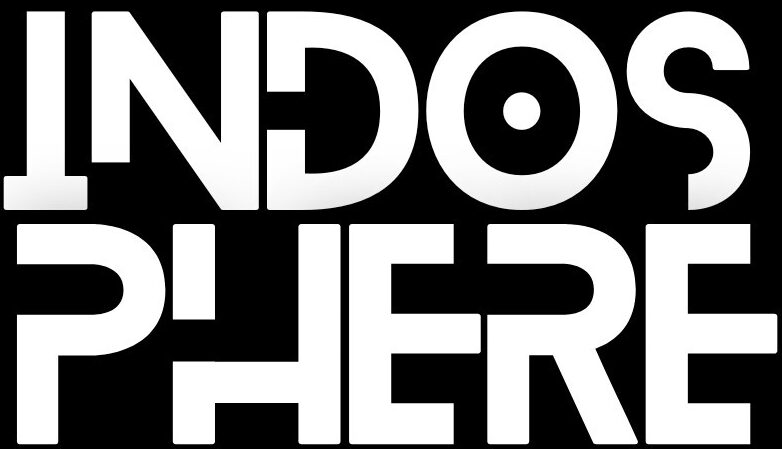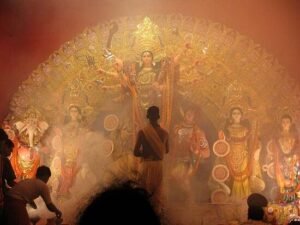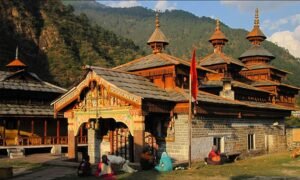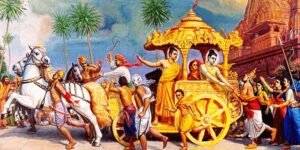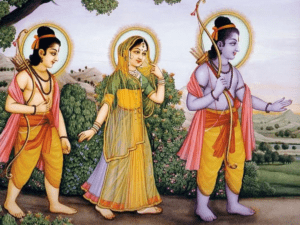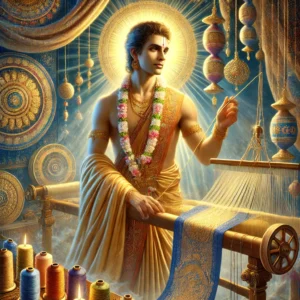Navaratri, the festival of nine nights, celebrates the eternal feminine power of Shakti in her nine forms, known as the Navadurga. Each day honors a distinct manifestation of the Goddess, representing a spiritual journey from creation, courage, and devotion to ultimate wisdom and liberation.

Day 1 – Maa Shailaputri: The Daughter of the Mountains
The first day of Navaratri invokes Maa Shailaputri, born as the daughter of the Himalayas. She rides a bull, holding a trident in one hand and a lotus in the other. Her name signifies her origin — Shaila (mountain) and putri (daughter).
In her past life as Sati, she immolated herself at Daksha’s yajna. Reborn as Parvati, she became the consort of Shiva once again. Shailaputri embodies strength and determination, grounding the devotee at the beginning of the spiritual journey. She governs the Muladhara Chakra, symbolizing stability and foundation.
Worshippers offer pure ghee to her, seeking health and strength, and chant “Om Devi Shailaputryai Namah”.
Day 2 – Maa Brahmacharini: The Ascetic Goddess
On the second day, the form of Maa Brahmacharini is worshipped, embodying devotion, austerity, and inner strength. She walks barefoot, holding a rosary in her right hand and a water pot in her left.
This form recalls Parvati’s long penance to attain Shiva as her husband. Her discipline and tapasya symbolize unwavering devotion and the power of meditation. She governs the Swadhisthana Chakra, connected to desire and creative energy.
Devotees offer sugar and fruits, believing she grants wisdom, peace, and liberation. Her mantra is “Om Devi Brahmacharinyai Namah”.
Day 3 – Maa Chandraghanta: The Warrior Goddess
The third day honors Maa Chandraghanta, recognized by the half-moon adorning her forehead like a bell. She appears in golden form, rides a tiger, and carries weapons in ten hands, ready for battle.
She represents courage and protects her devotees from evil forces. Chandraghanta governs the Manipura Chakra, the center of energy and willpower. Worshipping her removes fear and fills life with bravery and serenity.
Milk and milk-based offerings are made to her, while devotees chant “Om Devi Chandraghantayai Namah”.
Day 4 – Maa Kushmanda: The Cosmic Creator
The fourth day is dedicated to Maa Kushmanda, the creator of the universe through her divine smile. She is depicted with eight arms, riding a lion, carrying weapons, a rosary, and a nectar-filled pot.
She resides in the blazing sun, radiating life and light. Symbolically, she is associated with the Anahata Chakra, the heart center, giving warmth, love, and vitality.
Devotees offer malpua to her, praying for health, strength, and prosperity. Her mantra is “Om Devi Kushmandayai Namah”.
Day 5 – Maa Skandamata: The Mother of Kartikeya
On the fifth day, devotees worship Maa Skandamata, the nurturing mother of Skanda (Kartikeya), the commander of the divine army. She is seated on a lotus, with her son Kartikeya in her lap, and rides a lion.
She symbolizes motherhood, compassion, and selfless love, while also representing courage in the face of adversity. She governs the Vishuddha Chakra, linked with truth and communication.
Offerings of bananas are made to her, invoking blessings of wisdom, prosperity, and liberation. Her mantra is “Om Devi Skandamatayai Namah”.
Day 6 – Maa Katyayani: The Fierce Warrior Goddess
The sixth day venerates Maa Katyayani, born as the daughter of Sage Katyayana after his intense penance. She is a warrior form, carrying a sword, trident, and lotus, riding a lion.
Katyayani is associated with the slaying of the demon Mahishasura, symbolizing victory of righteousness over evil. She governs the Ajna Chakra (third eye), representing perception, intuition, and wisdom.
Devotees offer honey, seeking to remove obstacles in marriage and relationships. Her mantra is “Om Devi Katyayanyai Namah”.
Day 7 – Maa Kalaratri: The Fierce Protector
The seventh day is devoted to Maa Kalaratri, the fiercest form of the Goddess. With dark skin, disheveled hair, and three fiery eyes, she rides a donkey and carries a sword and an iron hook.
Despite her terrifying appearance, she is deeply protective and benevolent, destroying ignorance and granting fearlessness. She governs the Sahasrara Chakra, symbolizing transcendence.
Offerings of jaggery are made to her, believed to remove fears and bring auspiciousness. Her mantra is “Om Devi Kalaratryai Namah”.
Day 8 – Maa Mahagauri: The Radiant Goddess of Purity
On the eighth day, worship is offered to Maa Mahagauri, radiant and serene in her white attire, riding a bull. She holds a trident and damaru, while blessing devotees with her other two hands.
After her penance, Shiva bathed Parvati in Ganga’s waters, revealing her glowing form as Mahagauri. She represents purity, renewal, and inner peace, governing the Anahata Chakra once again, bringing compassion and harmony.
Devotees offer coconut to her, praying for peace and prosperity. Her mantra is “Om Devi Mahagauryai Namah”.
Day 9 – Maa Siddhidatri: The Bestower of Perfections
The ninth day is dedicated to Maa Siddhidatri, who grants spiritual perfections known as siddhis. Seated on a lotus or lion, she carries a lotus, mace, discus, and conch.
She governs the Sahasrara Chakra, the crown of spiritual consciousness, granting liberation and fulfillment. Even Shiva is said to have attained his powers by worshipping her, manifesting as Ardhanarishvara, the union of Shiva and Shakti.
Sesame seeds are offered to her, believed to protect from misfortune and grant divine grace. Her mantra is “Om Devi Siddhidatryai Namah”.
The Navadurga together represent the journey of the soul: from grounding in strength and devotion, through courage, creation, and compassion, to the ultimate gift of divine realization. Navaratri is not only a festival of worship but also an inner pilgrimage, guided by the radiant forms of the Mother Goddess.
